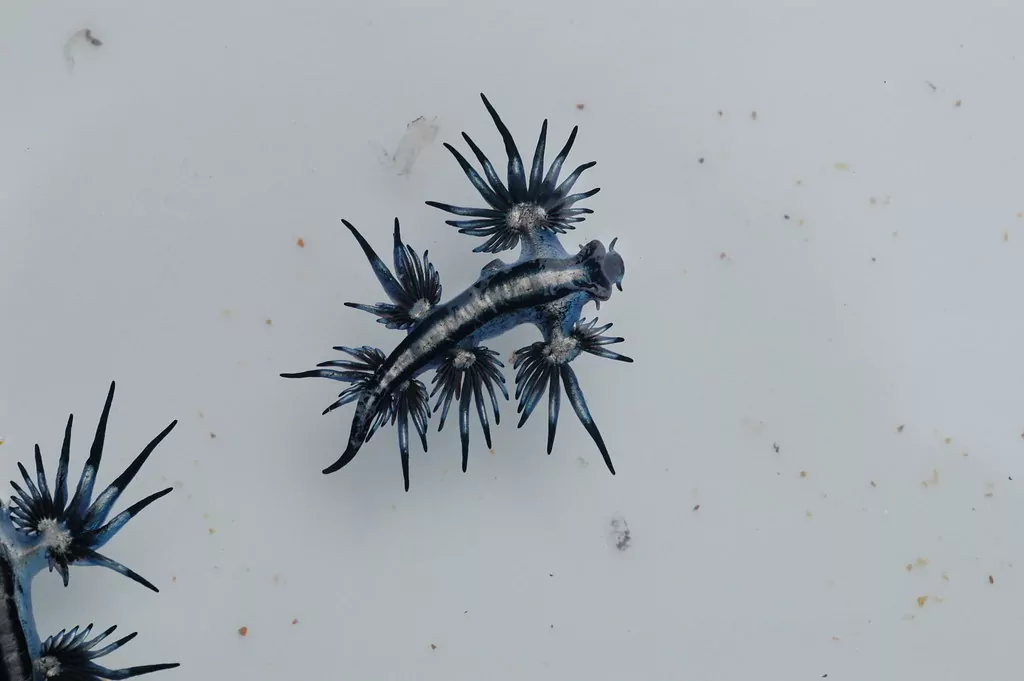Glaucus Atlanticus (Blue Dragon Sea Slug) Symbolism

The bright blue Glaucus atlanticus, also known as the blue dragon sea slug or blue angel, captivates with its vivid coloration and unique appearance. But beyond its visual appeal, the blue dragon holds symbolic meaning as well.
As an otherworldly sea creature that floats upside down on the ocean’s surface, the blue dragon represents transformation, adaptability, protection, and enlightenment. Its magical qualities have sparked the imagination for ages.
The Blue Dragon’s Transformative Nature
The blue dragon undergoes an incredible metamorphosis in its life cycle that allows it to transform toxicity into protection. After hatching, the tiny slug feeds exclusively on venomous Portuguese man o’ war jellyfish. Concentrating the man o’ wars’ stinging cells within its tissues, the blue dragon repurposes venom to defend itself throughout adulthood.
This process of turning poison into medicine mirrors the alchemical concept of transforming lead into gold. As such, the blue dragon symbolizes the ability to alchemize difficult life experiences into sources of strength and protection. It represents the transmutation of suffering into wisdom.
Masters of Adaptation
A specialized air sac allows the blue dragon to float effortlessly on the water’s surface, where it lives its whole life upside down. With no need to right itself, the blue dragon perfectly adapts to life at this unusual angle.
The sea slug’s upside down existence defies gravity and subverts expectations, much like the Fool card in Tarot. As the Fool boldly journeys into the unknown, the blue dragon shows us that adapting to life’s unexpected circumstances allows us to discover new perspectives.
Protection Through Camouflage
Countershading gives the blue dragon invisibility-like powers. Bright blue on its underside blends seamlessly into the ocean’s depths when viewed from below. Simultaneously, silver tones on its back disguise it against the shimmering sea surface when threats come from above.
The blue dragon’s camouflage ability symbolizes how adapting our outer appearance to blend into various environments can help us become invisible to threats. By flowing with our surroundings like water, we gain protection.
Creatures of Enlightenment
The blue dragon’s stunning blue color connects it to symbols of wisdom, power, and enlightenment. Representing infinity and the expansiveness of sea and sky, blue conjures images of the third eye chakra and unlimited spiritual potential.
When we see the dragon soaring weightlessly over glassy waters, we sense its enlightened state – freed from gravity and physical limitations. The visual brings to mind the sword Excalibur, granting power and insight to the true king. As enlightened beings, blue dragons invite us to join them riding the sea breezes, detached from earthly hindrances.
Key Takeaways: Decoding the Blue Dragon’s Magic
- The blue dragon represents the transmutation of toxicity into protective medicine through its unique feeding habits. It symbolizes transforming suffering into wisdom.
- Living upside down, the blue dragon embodies qualities like adaptability, defiance of expectations, and comfort in the unknown – much like the Fool in Tarot.
- With its camouflage abilities, the blue dragon is a master of using appearances for protection and invisibility.
- Vivid blue coloration connects the blue dragon to enlightenment and spiritual power symbols like the third eye chakra. Its floating, weightless dance conveys a detached, gravity-defying enlightened state.
So in its transformation, adaptability, invisibility, and transcendent blue color, the mystical blue dragon teaches us about transmuting obstacles into power and finding enlightenment in unexpected places. Harnessing its magic allows us to ride the sea breezes above worldly limitations.
FAQ about Glaucus atlanticus
What is Glaucus atlanticus?
Glaucus atlanticus, commonly known as the blue sea dragon or blue angel, is a small species of blue sea slug that belongs to the family Glaucidae. They are pelagic aeolid nudibranchs, which means they are shell-less mollusks that live in the open ocean.
How does Glaucus atlanticus stay afloat?
This sea slug floats upside down using the surface tension of the water, aided by a gas-filled sac in its stomach, which helps it stay at the surface and be carried along by winds and ocean currents.
What does Glaucus atlanticus eat?
The blue sea slug preys on other pelagic creatures including venomous siphonophores like the Portuguese man o’ war. It stores stinging nematocysts from its prey within its tissues as a defense mechanism.
Is Glaucus atlanticus dangerous to humans?
Handling Glaucus atlanticus can lead to a painful and potentially dangerous sting, as they store venomous nematocysts from their prey, which can cause symptoms similar to those of a Portuguese man o’ war sting.
Where can Glaucus atlanticus be found?
They are typically found in temperate and tropical waters around the world, including the east and south coasts of South Africa, European waters, the east coast of Australia, and Mozambique. They occasionally wash ashore on beaches, especially after strong winds or storms.





